'Government officials have not provided us anything.'
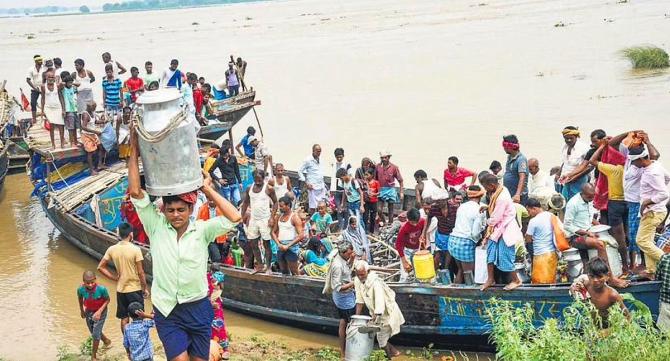
An angry monsoon and swollen rivers have left parts of Bihar marooned.
Among those who are battling this watery wrath are Gopi Mahto, Madan Sahni and Anita Devi.
They are just three of the hundreds of families displaced by the floods and forced to find relatively safer shelter.
Since a week, many villagers from Katihar district's Kursela block have been living near high-rise railway tracks, roads and embankments after flood waters inundated their homes.
The chances of the water receding -- large areas in these parts continue to remain submerged -- remain dim, with the Indian Meteorological Department forecasting more rain.
Bihar Chief Minister Nitish Kumar conducted an aerial survey of the worst-affected districts -- Bhagalpur and Khagaria -- on August 17.
The Ganga, Koshi, Bagmati and Burhi Gandak rivers, swollen heavily with rain water, have flooded hundreds of villages and displaced thousands; large tracts of kharif crops have also been damaged.
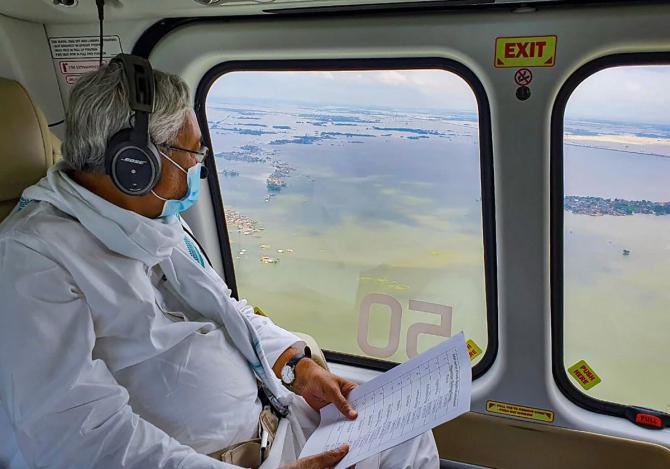
Gopi, Madan and Anita have one more tragedy in common -- they are yet to get any help from the government.
The only help some of them have received from the local administration are polythene sheets to cover their heads.
"We have been living near the railway tracks and surviving on dry sattu (flour made from roasted gram and corn), chura (flattened rice) and murhi (puffed rice)," Gopi, a resident of Kheria village, tells M I Khan.
"We survived the first two-three days on food we had managed to salvage. Since then, we have been struggling to survive. Lack of clean drinking water, toilets and boats have created additional problems," sighs Gopi.
Madan, who was forced to leave his village, Tingharia, and is now living with his family on the side of the state highway, says, "Government officials have not provided us anything. Sabhi log sattu khakar jee rahe hai. Bhojan kab milega pata nahi (We are surviving on sattu. I have no idea when we will get a proper meal)."
Anita, a resident of Pathar Tola, adds, "We have nothing to cook with. Our children have been crying due to hunger; we are somehow convincing them to survive on sattu and chura. It is very painful for us to see our children struggling like this."
Gopi, Madan and others have erected temporary covers over their heads with polythene sheets; some have managed to build temporary huts alongside railway tracks and roads. They are living there with their cattle, hens and ducks.
"We have no other option. Once the sun sets, we have no access to any kind of light until it rises again. The fear of poisonous snakes, scorpions and wild dogs is constant. During the day, we keep a close watch on our children as they play near the railway tracks," says Gopi.
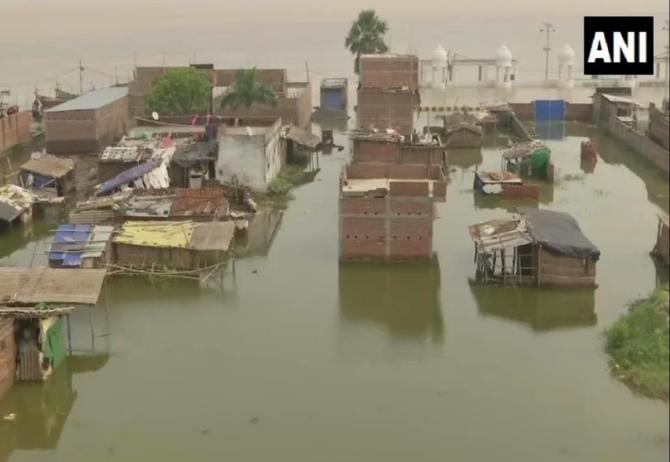
Numbers from the Bihar Disaster Management Department's August 17 flood report:
- More than 2.7 million people in 15 districts have been impacted.
Madhubani, East Champaran, West Champaran, Supaul, Darbhanga, Saran, Bhojpur, Patna, Samastipur, Vaishali, Katihar, Khagaria, Bhagalpur, Lakhisarai and Muzaffarpur are the affected districts. - 2,176 villages under 618 panchayats belonging to 93 blocks are affected.
- 85,424 people have been evacuated.
- About 48 flood relief camps and 505 community kitchens have been set up.
- 12 lives have been lost.
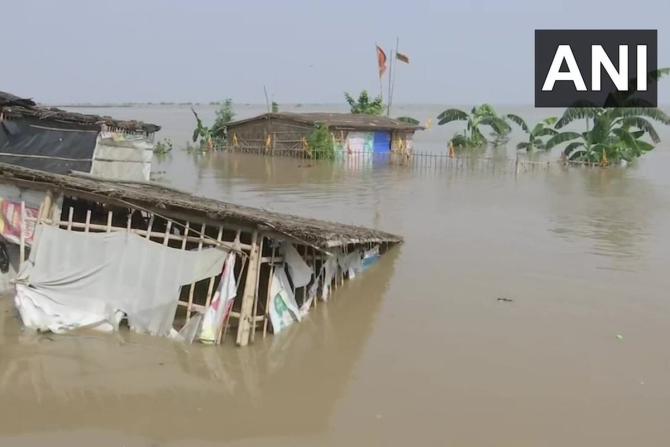
The rising waters of the Ganga are posing a serious flood threat to Patna.
Nearly three dozen panchayats in the district have been adversely affected after the river water entered low-lying areas along its banks.
Hundreds of displaced families and their cattle -- who live in villages in this riverine belt, known locally as Diara -- have taken shelter in Patna.
The Ganga's waters have also entered low-lying areas in Bhagalpur, Lakhisarai and Munger districts.
In Bhagalpur, some flood victims are trapped -- along with their cattle and horses -- on the roofs of their homes.
In Munger, people trapped on the roofs of their homes have pleaded with the government for food and water.
Due to waterlogging on the railway tracks, train services have been disrupted between Bhagalpur and Kahalgaon.

After heavy rains in Bihar and in catchment areas in neighbouring Nepal in the last few days, the water levels of the Ganga, Koshi, Gandak, Bagmati, Budhi Gandak and Sone rivers have risen to dangerous levels.
The state's water resources department has issued a flood alert in the flood-prone north Bihar districts that border Nepal.
Mahendra Yadav, founder of the Koshi Navnirman Manch, a local organisation that helps flood victims, says the unexpected early floods in mid-June soon after the monsoon arrived -- followed by four more floods till date -- has left thousands of farmers in distress as their crops were severely damaged across the Koshi, Ganga, Gandak and Bagmati river basins.
During the ongoing kharif season, sugarcane and paddy growers have experienced more or less a repeat of last year's disaster when the Gandak river flooded and destroyed their crops.
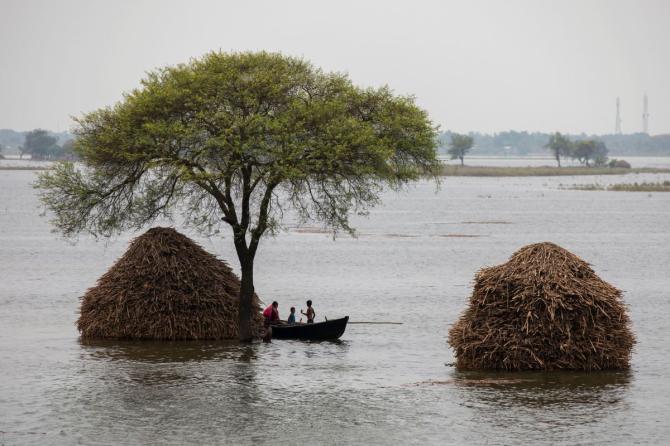
The state's disaster management department has asked people living in low-lying areas to move to higher ground as heavy rains continue.
In the flood-hit districts, the Bihar government has recalled doctors and health department officials who were on leave and launched relief and rescue operations.
More than two dozen teams of the National Disaster Response Force and the Bihar State Disaster Response Force have been deployed in the worst flood-hit pockets.
After holding a review meeting, Nitish Kumar has directed top officials to speed up the rescue and relief work.
According to officials, crops worth crores of rupees have been damaged and road links to several places have been snapped.
After the monsoon arrived on time in Bihar this year, the state has received surplus rainfall.
IMD officials in Patna said the state received 745.2 millimetres of rainfall from June 1 to August 14, which is 19 per cent more than normal. After their forecast of medium to heavy rainfall across the state over the next few days, the state government has alerted 28 of 38 flood-prone districts.
According to the water resources department's Web site, Bihar is the most flood-affected state, accounting for close to 17.2 per cent of the total flood-prone area in the country.
Out of 9.416 million hectares, 6.880 million hectares (76 per cent of north Bihar and 73 per cent of south Bihar) is flood-prone; this means that 28 of its 38 districts are in danger when the state receives excessive rain.
Feature Presentation: Rajesh Alva/Rediff.com











